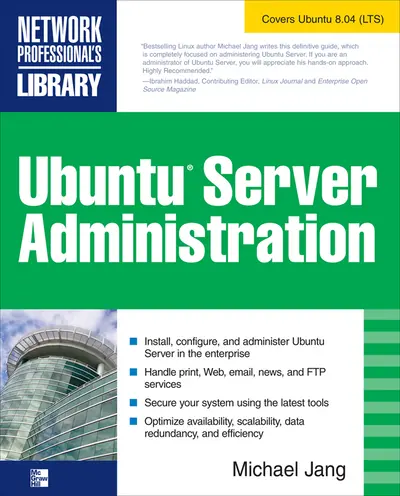My Account Details

ISBN10: 0071598928 | ISBN13: 9780071598927

Step 1 . Download Adobe Digital Editions to your PC or Mac desktop/laptop.
Step 2. Register and authorize your Adobe ID (optional). To access your eBook on multiple devices, first create an Adobe ID at account.adobe.com. Then, open Adobe Digital Editions, go to the Help menu, and select "Authorize Computer" to link your Adobe ID.
Step 3. Open Your eBook. Use Adobe Digital Editions to open the file. If the eBook doesn’t open, contact customer service for assistance.
Publisher's Note: Products purchased from Third Party sellers are not guaranteed by the publisher for quality, authenticity, or access to any online entitlements included with the product.
Administer Ubuntu Server in the Enterprise
Realize a dynamic, stable, and secure Ubuntu Server environment with expert guidance, tips, and techniques from a Linux professional. Ubuntu Server Administration covers every facet of system management--from users and file systems to performance tuning and troubleshooting. Learn how to automate installation using Kickstart, set up print and Web servers, configure and secure networks and TCP/IP ports, and implement Linux virtualization. You'll also get details on sharing resources via NFS and Samba, protecting your system, and customizing the Linux kernel.
- Install Ubuntu Server Edition in a production environment
- Use administrative commands, secure with the PolicyKit, and customize permissions with ACLs
- Configure filesystems in partitions, logical volumes, and RAID arrays.
- Configure secure remote administration using the Secure Shell and Landscape
- Manage updates and configure local repository mirrors
- Control users with quotas, PAMs, and authentication databases
- Build Web servers using Apache, MySQL, and PHP
- Handle security with AppArmor, Kerberos, iptables-based firewalls, and TCP Wrappers
- Virtualize your system using VMware, Virtualbox, and KVM
Covers Ubuntu 8.04 (LTS)
Introduction
Chapter 1. The Ubuntu Community
Chapter 2. Installing the Ubuntu Server
Chapter 3. Automated Installations with Kickstart
Chapter 4. The Boot Process and Rescue Mode
Chapter 5. Filesystem Configuration
Chapter 6. Command Line Tools and Shell Management
Chapter 7. Basic Administrative Tools
Chapter 8. Manage Updates and Local Repositories
Chapter 9. Printer Configuration
Chapter 10. User, Group, and Administrative Management
Chapter 11. Network Configuration and Troubleshooting
Chapter 12. Manage Network Authentication
Chapter 13. A Minimal Graphic Environment
Chapter 14. DHCP and DNS
Chapter 15. Web Servers and Apache's LAMP
Chapter 16. Create a File Server
Chapter 17. Other Services: Mail, FTP, and NTP
Chapter 18. Backups and Security
Chapter 19. Kernel Management
Chapter 20. Virtual Machines and Terminal Servers
Glossary
Index
Need support? We're here to help - Get real-world support and resources every step of the way.